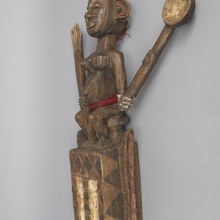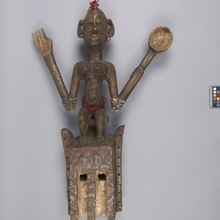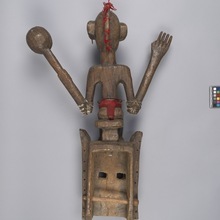Mask
MOA: University of British Columbia
3420/22
Carved and painted mask. The rectangular face section has two sunken rectangular areas on either side of the nose ridge, two rectangular cutout eye holes, and small pointed ears. The forehead is decorated with X's, creating a repeating diamond and triangle design that continues down each side of the face. The designs are painted dark red and black. The superstructure is a female figure with projecting breasts, square shoulders, arms bent at the elbow and held out to the sides. Her left forearm is shaped like a large ladle. She is wearing a red fibre skirt. She has red crest-like hair, and an earring in her left ear.
-
History Of Use
The figure commemorates the first woman, known as Satimbe, who discovered and wore a mask. Her mask was stolen by her husband who prohibited females from ever wearing them. It is also associated with the Yasigne, “sisters of the mask”, females born during the performance of the Sigi festival, a three-month long festival that seeks to honour ancestors every sixty years. The Yasigne are the only women allowed to approach the Satimbe masks. Masquerades involving this mask usually take place during the dry season festival, which acknowledges death and celebrates life and fertility. Satimbe masks are made by blacksmiths using an adze and a single piece of wood; often from the toglo tree. The Dogon believe that trees contain nature spirits, so they carry out rituals before a tree is cut to allow the spirit to be transferred to a new vessel.
- Type of Item mask
- Culture Dogon
- Material shell, wood, fibre, metal, paint
- Measurements height 75.5 cm, width 51.0 cm, depth 15.5 cm (overall)
- Previous Owner Richard Tchuemegne
- Received from Richard Tchuemegne, Michael O'Brian Family Foundation, Museum of Anthropology Exhibitions Budget
- Made in Mali
- Creation Date during 1950
- Ownership Date before February 5, 2020
- Acquisition Date on February 5, 2020
- Condition fair
- Accession Number 3420/0022



